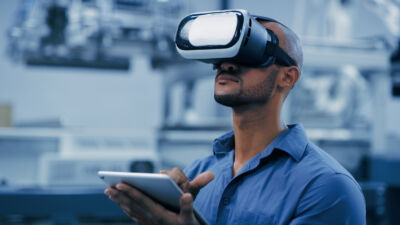 Introduction:
Introduction:
Inteleos recently announced its partnership with Vantari, an award-winning Australian company known for its innovation in virtual healthcare education. Together, we will launch our first-ever Inteleos virtual reality (VR) project designed specifically for sonography training. This collaboration holds the promise of reshaping the way student sonographers learn and practice, ushering in a new era of immersive and effective education.
Why VR?
The decision to venture into virtual reality for sonography training is not just about embracing cutting-edge technology; it’s about revolutionizing the educational landscape. Virtual Reality provides an unparalleled immersive experience, allowing learners to step into realistic scenarios that mimic the challenges they will face in their future careers. The concept of “sense of presence” is at the core of this experience, heightening emotional connections and reducing cognitive load. This, in turn, accelerates the speed of learning acquisition and improves retention, setting the stage for a more effective and engaging learning journey.
The Mastery Learning Approach:
Central to our VR modules is the Mastery Learning Approach, a philosophy built on the belief that with sufficient time, proper instruction, and determination, students can achieve unprecedented levels of understanding. Within the safe and controlled environment of VR, students can make mistakes, learn from them, and continually refine their skills. This personalized and iterative approach ensures that each student progresses at their own pace, mastering the required skills before moving on to more advanced concepts.
Affordability and Efficiency:
One of the standout advantages of our VR venture is its cost-effectiveness. Studies have shown that VR can be up to 83% more affordable than traditional manikin-based simulations. This cost-effectiveness, coupled with scalability, translates to greater scheduling flexibility and reduced maintenance costs for educators. By serving as a bridge between classroom training and hands-on experiences, VR optimizes the time spent in real-world clinical labs, making the educational process more efficient and impactful.
Feedback and Real-World Relevance:
Our VR modules are being designed with meticulous attention to detail, ensuring that every activity is physics-based and replicates real-world dynamics. This crucial element ensures that the skills students develop in the VR realm seamlessly translate to real-life clinical scenarios. Moreover, an interactive dashboard provides real-time metrics on student performance, enabling continuous improvement and personalized feedback, further enhancing the educational experience.
Global Adoption and Vision for the Future:
The demand for VR in healthcare applications is skyrocketing globally. From surgical simulations to educational platforms, the potential applications are immense. Our VR modules, starting with ARDMS Abdominal content, aim to democratize simulation-based education by making it accessible to anyone with a VR headset. This initiative is not confined to local outreach; our vision spans across borders, making high-quality education attainable for aspiring sonographers worldwide.
A Special Note of Thanks:
To our incredible Inteleos volunteer community, we extend our heartfelt gratitude. Your unwavering support and belief in our mission have made endeavors like this possible. Together, we are not just embracing the future; we are actively creating it. Your contributions empower us to continue pushing the boundaries of education and technology, ultimately shaping a future where learning knows no bounds.
Conclusion:
This collaboration stands as a testament to Inteleos’ commitment to innovation and excellence in healthcare education. The launch of the Inteleos VR project with Vantari marks a pivotal moment, and we are excited to witness the transformative impact it will have on the next generation of sonographers. The journey doesn’t end here; it’s a stepping stone towards a future where virtual reality becomes an integral part of medical education, breaking barriers and fostering a new era of accessible and effective learning.
*AI was used to edit and format this blog post.






